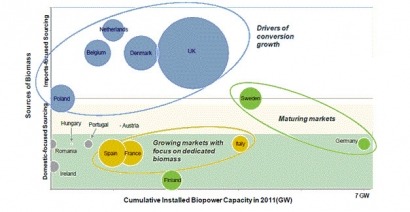
Biopower, which uses biomass for electricity generation, is a niche market but one that is expected to grow rapidly in Europe as utilities turn to the technology as a source of reliable and cost-competitive renewable power, according to a market study from IHS Emerging Energy Research.
Although wind and solar power will continue to dominate the European renewables market, biopower is an attractive option for utilities looking to cope with intermittent supplies from wind and to maintain their existing coal-fired power stations, according to the study "Europe Biopower Markets and Strategies: 2012 - 2035"
IHS Emerging Energy Research therefore forecasts that biopower capacity will grow by 30 gigawatts (GW) to 56 GW between 2012 and 2035, representing six percent of the additional renewable capacity in the European Union.
However, the study notes that the industry faces a number of challenges - including a continuing need for subsidies - that could hamper its expansion despite the EU's drive towards more renewable energy.
"The challenges in sourcing high-quality and sufficient biomass feedstock as well as the uncertain financial support for biopower generation constrain the development of biopower capacity in the EU," said Marianne Boust, Associate Director at IHS Emerging Energy Research who led the study.
The EU's scarcity of domestic wood resources means it will increasingly rely on imported biomass feedstock. In addition, biopower currently is not competitive with wholesale power prices and relies on government support and so market growth is influenced by financial incentives.
The EU is the world's second largest biopower market with 30 GW of new additions by 2035, behind Asia Pacific (46GW) but surpassing Latin America (29 GW).
Growth in the EU will be led in the short term by the construction of new dedicated biomass plants. In the longer-term, growth will come from the conversion of coal to biomass plants driven by environmental regulations and higher carbon prices.
For additional information:

